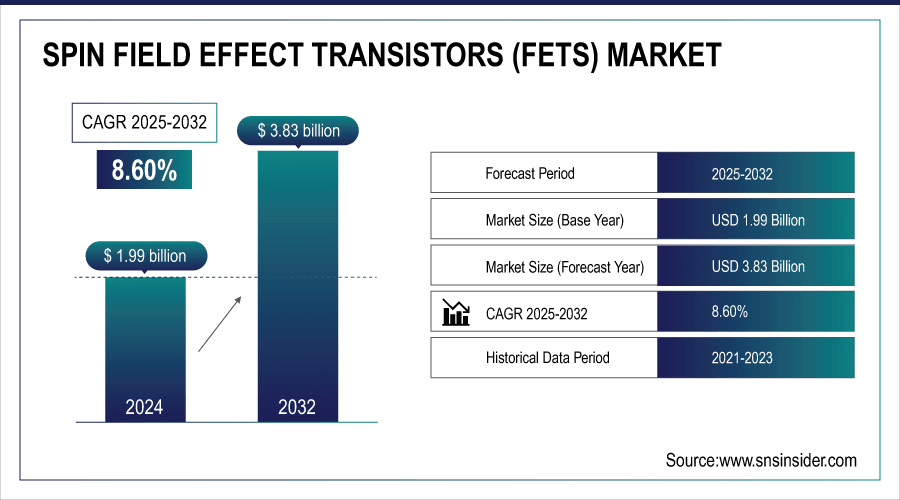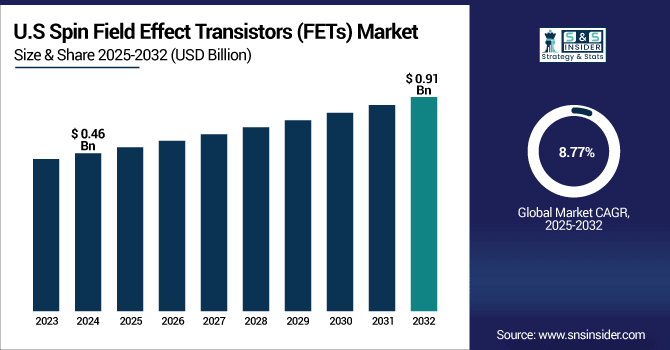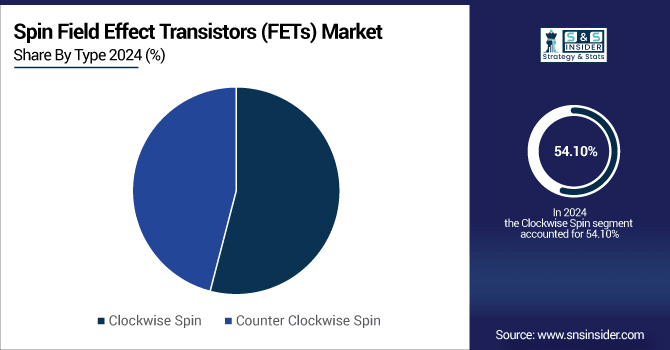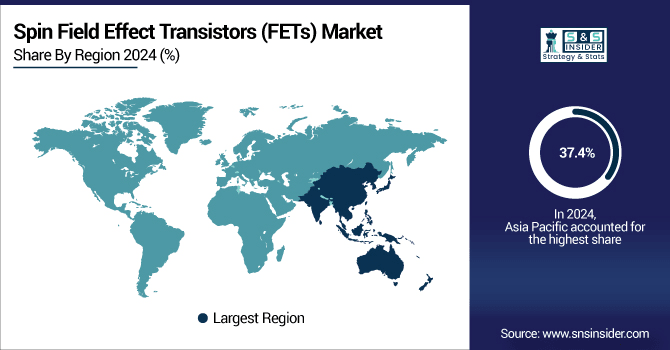Spin Field Effect Transistors (FETs) Market Size & Growth:
The Spin Field Effect Transistors (FETs) Market size was valued at USD 1.99 billion in 2024 and is expected to reach USD 3.83 billion by 2032, growing at a CAGR of 8.60% over the forecast period of 2025-2032. Factors, such as increasing demand for energy-efficient and high-speed electronic devices, the growing interest in quantum computing, and emerging spintronics technology for non-volatile memory and improved data processing capabilities in several industries drive the growth of the Spin Field Effect Transistors (FETs) Market.

To Get More Information On Spin Field Effect Transistors (FETs) Market - Request Free Sample Report
Rising technological advancement and the demand low-power and high-performance electronic devices in consumer electronics, IT and automotive sector is expected to drive the Spin Field Effect Transistors (FETs) Market growth. Spintronics that will use electron spin for data storage and processing are providing faster, energy-efficient devices. Moreover, increase in demand for advanced application in quantum computing and next generation logic devices are expected to drive the demand for spin-FETs. Also, non-volatile feature and better scalability further help them being embedded in future semiconductor architectures.
-
Everspin Technologies has developed Toggle MRAM, a non-volatile memory that retains data for up to 20 years across a wide temperature range (-40°C to 150°C). This technology utilizes magnetoresistive tunnel junctions (MTJs) to achieve durable, high-density memory solutions.
The U.S. Spin Field Effect Transistors (FETs) Market size is estimated to be valued at USD 0.46 billion in 2024 and is projected to grow at a CAGR of 8.77% reaching USD 0.91 billion by 2032. Rise in advanced semiconductor research due to effective government and private investments has also helped to grow the U.S. Spin Field Effect Transistors (FETs) Market, along with an increase in demand for energy-efficient electronics thereby boosting the use of spintronics in quantum computing, data storage, and next-gen logic devices.

Spin Field Effect Transistors (FETs) Market Dynamics:
Key Drivers:
-
Rising Demand for Energy Efficient High-Speed Electronics Accelerates Growth of Spin Field Effect Transistors
The growing demand for low-power, high-speed electronic devices in sectors, such as consumer electronics, information technology, automotive, and healthcare, are expected to be the key market drivers for the global Spin Field Effect Transistors (FETs) Market. Faster data processing coupled with lower power consumption facilitates the adoption of spintronics technology in memory storage (memories), logic devices, and quantum computing. The other driver of market growth is increasing investments in quantum computing research and development, which also broaden the applications for spin-FETs. Integration also supports next-generation semiconductor architectures due to the growing demand for non-volatile memory solutions with improved scalable performance.
-
Quantinuum, a quantum computing company majority-owned by Honeywell, secured a USD 1 billion deal with Qatari investment firm Al Rabban Capital to accelerate quantum adoption in Qatar, focusing on applications in finance, precision medicine, and genomics.
Restraints:
-
Integration Challenges and Spin Stability Issues Hinder Commercial Scalability of Spin Field Effect Transistors
The complexity of integration with existing semiconductor fabrication technologies may be one of the key challenges facing the Spin Field Effect Transistors (FETs) Market. Spin-FETs need specially made ferromagnetic and semiconductor materials, which commonly exhibit interface problems dealing with spin injection efficiency, spin coherence, and thermal stability. An additional major challenge that is needed to be overcome lies in extending the lifetime of the induced electron spin polarization at room temperature for a more considerable distance, which will ultimately be needed to scale these devices towards commercial usage.
Opportunities:
-
Expanding Applications and Material Innovations Unlock Growth Opportunities for Spin Field Effect Transistors Globally
Growing application of the spin-FET in various fields, such as quantum information processing and spin-based sensor for the automotive and healthcare sectors can present opportunities. Rapid growth of semiconductor manufacturing along with government support initiatives is anticipated to create lucrative growth opportunities in the Asia Pacific region. Also, development of ferromagnetic materials innovations and hybrid semiconductor-ferromagnetic devices where improve the performance of the device as well as the devices in upcoming market place globally.
-
The U.S. and India have launched the Initiative on Critical and Emerging Technology (iCET) to enhance cooperation in developing technologies like quantum computing. Under iCET, both countries announced over USD 2 million in grants for AI and quantum technology research projects in 2024.
Challenges:
-
Lack of Standardization and Industry Collaboration Slows Commercial Adoption of Spin Field Effect Transistors
The absence of standardized manufacturing processes and testing protocols impedes widespread utilization. Spintronic devices are still an experimental concept for the most part, with the market still in a maturing stage. Additionally, the lack of existing supply chains and little collaboration between industries stymie new applications from moving from prototype to volume production. Addressing these technological barriers will necessitate significant R&D, infrastructure resources and wider recognition across the semiconductor and electronics value chain.
Spin Field Effect Transistors (FETs) Market Segmentation Analysis:
By Material Type
Semiconductors have accounted for most of the Spin Field Effect Transistors (FETs) Market share in 2024 owing to their popularity that comes from already implementation in modern CMOS technology, ease of fabrication, and the compatibility with established electronic circuits. Semiconductors allow good control of spin-polarized currents, and thus serve as a basis for the first steps in spin-FET.
During 2025-2032, ferromagnetic materials are anticipated to record the fastest growth. These materials are of particular interest as they can sustain and control spin polarization, a central functionality of spintronic devices. Due to their energy efficiency and speed improvements over the current option, ferromagnetic semiconductor integration innovations will be necessary as people transition into the next generation of applications, such as quantum computing and spin-based sensors.
By Application
The Spin Field Effect Transistors (FETs) market was dominated by data storage with a 41.1% share in 2024, largely due to the growing demand for fast, energy-efficient, and non-volatile memory storage. Spin-FETs are a valuable alternative for memory storage, with a lower power, higher stability, and higher speed. These characteristics render them suitable candidates for the replacement of traditional memory technologies in consumer electronic devices, data centers and enterprise computing systems.
Quantum computing is projected to grow fastest in the Spin-FET market over 2024-2032. Due to their functionality for spin manipulation at nanoscale dimensions, spin-FETs have been investigated as good qubit candidates, especially with regard to new demands due to increasing quantum information processing capabilities. Spintronic-based quantum architectures are attracting massive investments from research institutions and tech giants, making this segment poised for quick scaling.
By Type
Clockwise Spin configurations held the highest share (54.1%) among the Spin Field Effect Transistors (FETs) market in 2024, which is attributed to stable spin polarization and control due to their suitability to conventional spintronic device designs. Clockwise spin is compatible with the present orientations of our magnetic fields, and because it can be fabricated using normal techniques, it is a solution that could lead to mass integration in consumer electronics and memory storage.

Counter Clockwise Spin configurations are projected to have the Highest-CAGR growth over 2025-2032. These spin states are being investigated for use in novel logic devices and quantum computing as other spin configurations can provide higher switching frequencies and improved energy efficiency. More exotic materials and spin-control mechanisms should reveal new applications, bringing counter clockwise spin configurations to the forefront.
By End Use
In 2024, consumer electronics segment accounted for the highest Spin FETs market share of 38.4% owing to the growing demand for compact, energy-efficient, and high-performance devices, such as smartphones, wearables, and laptops. These applications are best suited for devices with low power consumption and fast switching, such as Spin-FETs. These help in improving data retention and allow memory systems to remain functional during a power loss, making them an excellent choice in modern consumer electronic devices looking for not just better processing power but also longer battery life.
The automotive segment is anticipated to gain the highest CAGR during 2025-2032 owing to the increasing integration of electronics in electric vehicles (EVs), driver-assistance, and infotainment systems. Booming data-processing ability at superfast speed and immunity against electromagnetic interference (EMI) by spin-FET make it the best choice for automotive applications that require safety-critical features. The spintronic components are expected to spread as vehicles get ever more digital and autonomous, but the jump should happen quickly.
Spin Field Effect Transistors (FETs) Market Regional Outlook:
The Asia Pacific held the largest market share of 37.4% in 2024 and is expected to witness the highest CAGR of 8.90% over 2025-2032. The demand is propelled by rapid growth in semiconductor manufacturing, increasing adoption of advanced electronics, and government funding to develop next-generation devices, such as spintronics and quantum computers. The region has a well-established electronics ecosystem, schools and research institutes are increasing in number and investment in R&D and fabrication infrastructure. The rise of new applications for spin-FET in markets, such as consumer electronics, automotive and industrial automation is also providing a key driver for the development and commercialization of spin-FET in the region, further strengthening the leadership in the market and the regional growth outlook for such emerging technology.

The Asia Pacific Spin Field Effect Transistors (FETs) Market was dominated by China owing to its large-scale semiconductor manufacturing base along with strong investment in spintronics research and development and rapid growth in electronics and electric vehicle sectors.
The Spin Field Effect Transistors (FETs) Market in North America is driven by a strong technological structure and is & technology leader in the world in Semiconductors. Considered to be the leading region with the highest investments in research and development for spin-FET applications, such as spintronics and quantum computing. Further, increased adoption rates of electronic devices in information technology, healthcare, automotive, and other industries is helping in the growth of the market. The combination of research from academic institutions and industry partnerships accelerates the commercialization of spintronic technologies leading the rest of North America into new generations of semiconductor solutions while supporting reliable market growth.
In North America, the U.S. led the spin FETs market given the country has strong semiconductor research, higher technology infrastructure, and a strong presence of key market players in the country. Innovations and commercial activities have accelerated due to substantial government funding for quantum computing and spintronics research and large private sector investments.
Spin Field Effect Transistors (FETs) are becoming increasingly relevant and Europe is emerging as a strong contender in the market due to the rising emphasis on sustainable electronics, widespread research and development (R&D) on advancements in spintronics, and growing public and private support for semiconductor innovation. A solid academic and research infrastructure supports advancement in quantum computing and spin-based devices in the region. The increased demand for low-power high-performance technologies across various industries, including automotive, telecommunications, and healthcare, is driving the growth of adoption.
The Spin Field Effect Transistors FETs Market in Europe was led by Germany owing to the substantial semiconductor manufacturing base, the advanced research in spintronics, and considerable investments in microelectronics and quantum technologies.
Emerging regions, such as Latin America and the Middle East & Africa are in the nascent stage of growth in the Spin FETs market, with incremental growth attributed to the growing inclination for advanced electronics and digital transformation. Though these regions have minimal semiconductor infrastructure now, burgeoning investments in research, education, and tech-based development are creating a strong long-term prospect. Rising investments in automation, technology and innovative spintronics generation in consumer products, healthcare technology, and automotive innovation is driving the trend of spintronics exploration.
Key Players:
Some of the major Spin Field Effect Transistors (FETs) Companies are Intel, IBM, Samsung, GlobalFoundries, Infineon, NXP, Qualcomm, TSMC, AMD, and SK Hynix.
Recent Developments:
-
In December 2024, Intel fabricated 12-spin-qubit arrays using a 300 mm semiconductor manufacturing line, marking a major step toward scalable quantum computing. The "Tunnel Falls" chip showcases industrial-level spin qubit production using standard high-volume processes.
-
In March 2024, Samsung announced a collaboration with Arm to develop next-generation Cortex-X CPUs using its 2nm Gate-All-Around (GAA) process technology. This initiative aims to enhance performance and power efficiency for future AI and mobile computing applications.
| Report Attributes | Details |
|---|---|
| Market Size in 2024 | USD 1.99 Billion |
| Market Size by 2032 | USD 3.83 Billion |
| CAGR | CAGR of 8.60% From 2025 to 2032 |
| Base Year | 2024 |
| Forecast Period | 2025-2032 |
| Historical Data | 2021-2023 |
| Report Scope & Coverage | Market Size, Segments Analysis, Competitive Landscape, Regional Analysis, DROC & SWOT Analysis, Forecast Outlook |
| Key Segments | • By Material Type (Semiconductors, Ferromagnetic Materials and Insulators) • By Application (Data Storage, Logic Devices, Quantum Computing, Sensors and Others) • By Type (Clockwise Spin and Counter Clockwise Spin) • By End Use (Consumer Electronics, IT and Telecommunications, Automotive, Healthcare and Others) |
| Regional Analysis/Coverage | North America (US, Canada, Mexico), Europe (Germany, France, UK, Italy, Spain, Poland, Turkey, Rest of Europe), Asia Pacific (China, India, Japan, South Korea, Singapore, Australia, Taiwan, Rest of Asia Pacific), Middle East & Africa (UAE, Saudi Arabia, Qatar, South Africa, Rest of Middle East & Africa), Latin America (Brazil, Argentina, Rest of Latin America) |
| Company Profiles | Intel Corporation, IBM Research, TSMC, Samsung Electronics, Infineon Technologies, GlobalFoundries, NTT Basic Research Laboratories, Toshiba Corporation, IMEC, Spintronics Inc. |

